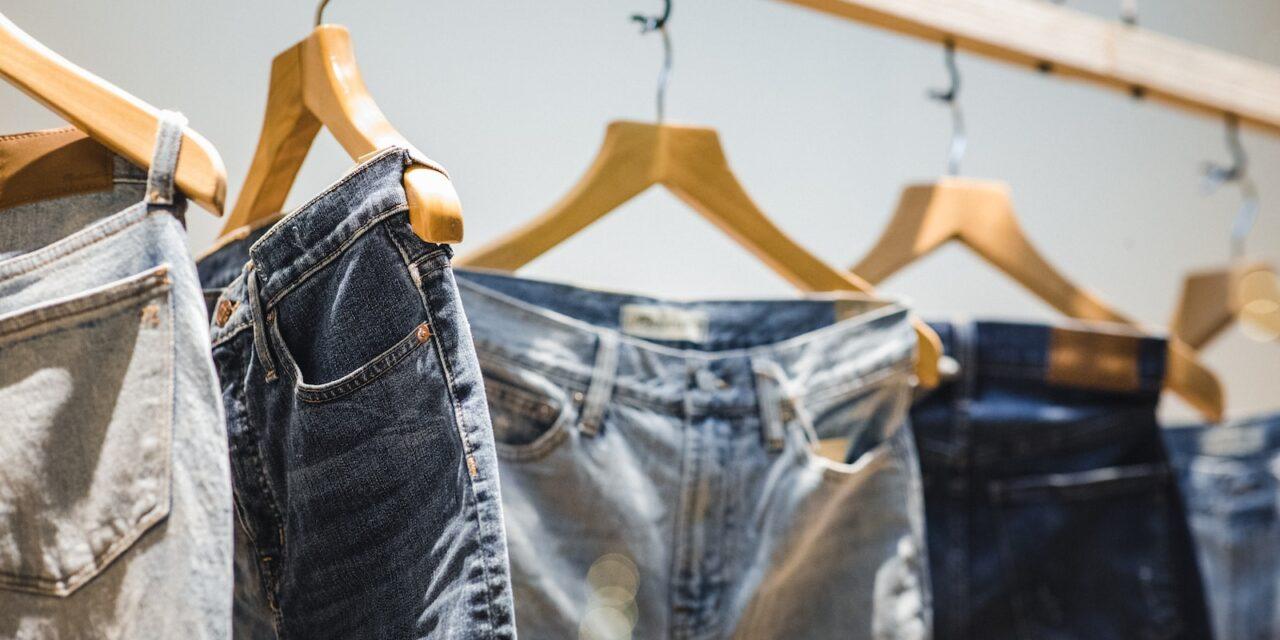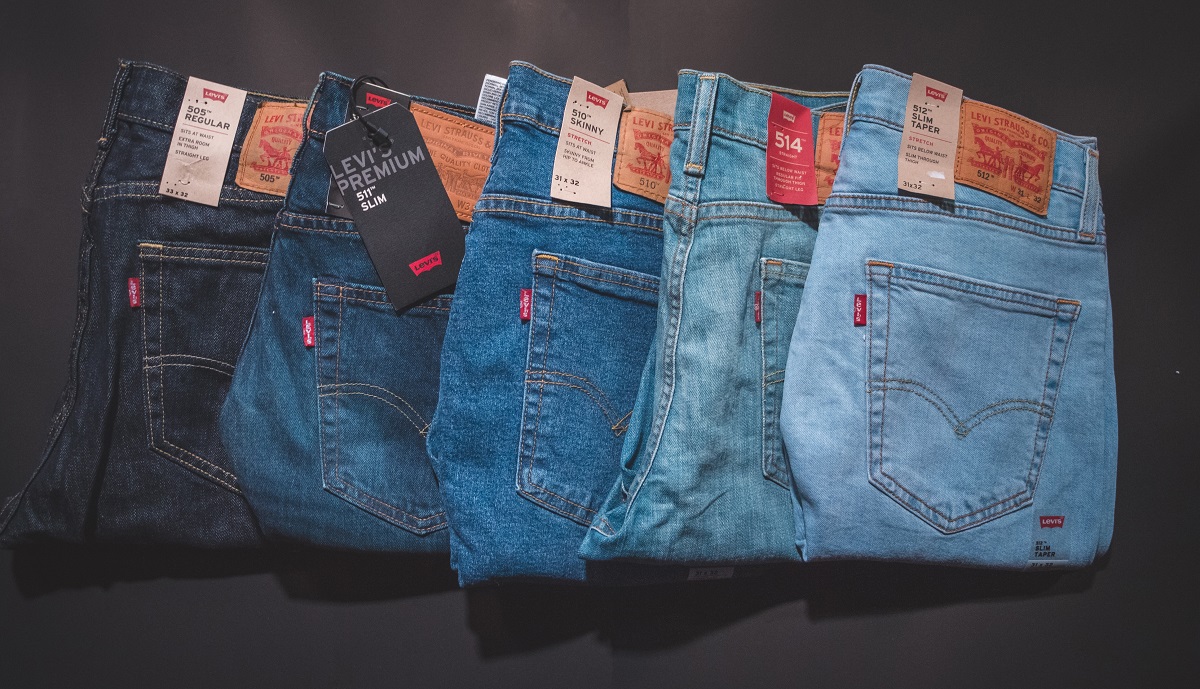Jeans are a staple in many wardrobes, worn by both men and women alike. They are versatile and can be dressed up or down, making them suitable for any occasion. However, finding the perfect pair can be a daunting task. In the article; “how to know if a pair of jeans fit” we highlight 4 key details to look for.
The right fit is essential for both comfort and style, and the wrong pair can leave you feeling uncomfortable and self-conscious. Having a well-fitting pair of jeans in your wardrobe is not only practical but also important for your confidence.
When you feel comfortable in what you’re wearing, it shows – you stand taller, move more freely, and exude confidence. Investing time into finding the perfect pair will pay off in the long run as they will become a go-to item that makes you feel good every time you wear them.
Common Misconceptions about Jean Sizing
One of the common misconceptions about jean sizing is that all brands follow standard sizing charts. However, this couldn’t be further from the truth – each brand has their own sizing system which can vary drastically between brands, even within different lines under the same brand. Another misconception is that your jean size never changes once you have found your perfect fit.
This isn’t true since factors such as weight fluctuations or changes in body shape can alter your measurements over time. Some people believe that if jeans fit perfectly when trying them on at home or at a store then they’ll always fit perfectly throughout wear.
Unfortunately though this isn’t true because denim fabric stretches over time depending on use frequency that leads to changes in fit over time. Finding a well-fitting pair of jeans takes effort but it’s worth it as it can impact not only how comfortable you feel but also how confident you appear.
Understanding the common misconceptions around jean sizing can save you time and frustration. In the next section, we’ll discuss the different types of jean cuts and how to assess which cut is right for your body type.
1. Understanding Jean Sizing
Jeans are a staple in most people’s wardrobes, but finding the perfect pair can be challenging. One of the most important aspects of finding the right fit is understanding jean sizing. It’s important to know that not all jeans are created equal, and sizing can vary greatly between brands and styles.
Different types of jean cuts (e.g., skinny, straight, bootcut)
When it comes to jean cuts, there are several different options to choose from. Skinny jeans offer a tight fit from waist to ankle and are typically made with stretchy material.
Straight leg jeans have a similar fit through the thigh but offer a looser fit around the calf and ankle. Bootcut jeans have a fitted thigh with a slight flare at the bottom, making them ideal for wearing with boots.
It’s important to choose a cut that flatters your body type and suits your personal style. Skinny jeans can elongate legs and highlight curves, while bootcut jeans offer balance for those with wider hips or thighs.
The importance of knowing your waist and inseam measurements
Knowing your waist and inseam measurements is crucial when it comes to finding the perfect pair of jeans. Take measurements at home using a tape measure, or visit a professional tailor or store that offers measurement services.
The waist measurement should be taken at the smallest part of your torso above the belly button, while the inseam measurement should be taken from your crotch to just below your ankle bone. Having these measurements on hand will make shopping for jeans much easier as you’ll be able to compare them against sizing charts for different brands.
The impact of fabric type and stretch on fit
The fabric type and amount of stretch also play an important role in how well jeans fit. Denim is traditionally made from 100% cotton but can also contain various blends of polyester, spandex, and other materials. Stretchy materials like spandex can make jeans more comfortable and forgiving of different body shapes, while 100% cotton denim may be stiffer and take longer to break in.
It’s important to consider fabric type and stretch when choosing a pair of jeans that will fit well for your specific body shape and activity level. Consider the activities you’ll be doing while wearing the jeans – if you’re going to be sitting or bending frequently, stretchy material may be a better option for comfort.
2. Assessing the Fit
How to check for proper waist fit (e.g., no gaping or muffin top)
The waistband of your jeans is one of the most important areas to assess when determining whether or not they fit correctly. To ensure a proper fit, the waistband should sit comfortably on your hips without any gaps or extra fabric bunching up around the waist. A good way to check for proper waist fit is to insert two fingers between your skin and the waistband.
If you can comfortably do this without experiencing any pinching or resistance, then you have found a pair that fits well. It’s important to note that many people mistakenly believe that buying jeans in a smaller size will result in a better-fitting garment.
However, choosing too small of a size can actually lead to muffin top due to excess skin and fat being squeezed out over the top of the band. For optimal comfort and style, make sure there is enough room for movement while still hugging your curves in all the right places.
Evaluating the thigh and hip area for comfort and mobility
While jean sizing standards have generally improved over time, it’s no secret that women’s bodies come in a variety of shapes and sizes. That’s why it’s important to evaluate not only how well jeans hug your curves but also how comfortable they are during everyday activities like sitting, standing, or walking. When evaluating thigh and hip area fit, be sure jeans aren’t pulling too tightly across these areas as this could indicate an incorrect size selection.
On the other hand, if there is too much fabric bunching up around these areas then you might want to consider trying on another cut or style. To ensure optimal mobility while still looking fashionable, choose cuts that provide enough room in key areas like thighs hips without being too baggy overall.
Checking the length to ensure proper hemming
One of the most common mistakes when it comes to purchasing jeans is not paying enough attention to length. If you’re on the shorter side, then you might assume that all jeans are simply too long and will require hemming.
While this might be true for some pairs, it’s important to first check if a particular style offers petite or short sizing. On the other hand, if you’re taller then you might need to look for brands that offer longer inseams or specialty styles designed specifically with tall women in mind.
Ultimately, checking the length of your jeans before purchasing is crucial as ill-fitting lengths can detract from an outfit’s overall look and feel. When trying on pants, make sure they hit just at or above your ankle bone for a flattering leg line.
3. Additional Considerations
How to account for potential shrinkage after washing
One of the most important things to consider when buying a new pair of jeans is that they will inevitably shrink after washing. The amount of shrinkage can vary depending on the fabric and construction of the jeans, so it’s essential to read the care label before purchasing. To prevent shrinking, it’s best to wash your jeans in cold water and hang them up to dry.
If you must use a dryer, use low heat and remove them promptly from the dryer. Avoid using hot water or high heat in the dryer as it can damage the fibers and result in more shrinkage.
If you’re concerned about potential shrinkage, consider sizing up when purchasing your jeans. This will give you more room for error and allow for some shrinkage without compromising fit.
The importance of trying on multiple sizes and styles
It’s common knowledge that jeans come in a variety of sizes, but what many people don’t realize is that each brand has its own sizing system. This means that a size 6 at one store may fit differently than a size 6 at another store. It’s essential to try on multiple sizes and styles to find what works best for your body type.
Additionally, different cuts (e.g., skinny, straight) can impact how a pair of jeans fits your body. For example, someone with wider hips may prefer a bootcut style over skinny jeans as they provide more room in the hip area.
It’s also worth mentioning that jean sizes can vary within the same brand depending on fabric type and stretchiness. Trying on multiple styles with different fabrics will give you a better idea of what fits best for your body type.
Tips for shopping online
Shopping online can be convenient but challenging when it comes to finding the perfect pair of jeans. It’s essential to do your research before making a purchase.
Start by reading the product description carefully, paying attention to the fabric content and care instructions. Look for reviews from other customers who have purchased the same style and size to get a better idea of how they fit.
Many online retailers offer free returns, which can give you peace of mind when trying a new brand or style. If possible, order two sizes and return the one that doesn’t fit as well.
Don’t be afraid to reach out to customer service if you have any questions about sizing or fit. They can provide valuable insight and help guide you in the right direction.
4. Rarely Known Small Details
How to check if back pockets are flattering or not.
Did you know that the placement and size of the back pockets on your jeans can make or break their overall look? To determine if the back pockets are flattering, stand in front of a full-length mirror and take a close look. If the pockets are too small or placed too high on your buttocks, they can make your rear end appear saggy or flat.
On the other hand, pockets that are too big or placed too low can create a droopy appearance. Ideally, the back pockets should be proportional to your body size and shape.
They should be centered on each cheek and positioned at just the right height to lift and enhance your natural curves. When shopping for jeans, don’t be afraid to try on several pairs until you find a pocket style that flatters your figure.
The impact of pocket placement on overall fit.
In addition to affecting how your buttocks look, pocket placement can also have an impact on how well your jeans fit overall. For example, if you have wide hips and find that most jeans gap at the waistband, look for styles with forward-facing side seams. These seams will pull in toward your body at just the right spot to prevent gaping and give you a snug, secure fit.
On the other hand, if you have narrow hips and want to create more curves in all the right places, choose jeans with angled side seams. These will add volume where you need it most while also creating a flattering hourglass shape.
Remember that pocket placement is just one factor in finding jeans that fit perfectly. It’s important to consider all aspects of fit when shopping for denim so that you end up with a pair that looks amazing from every angle.
The importance of trying on multiple sizes and styles.
One of the most important things you can do when shopping for jeans is to try on multiple sizes and styles. Even if you know your measurements and have a good idea of what cut you want, every brand and style of jeans fits differently.
When trying on jeans, don’t be afraid to go up or down a size or try a different cut than what you’re used to. You may find that a smaller size fits better in one brand while a larger size works better in another.
Similarly, trying on different cuts can help you find the silhouette that flatters your body type best. Remember that finding the perfect pair of jeans takes time and patience.
Be willing to explore different options and trust your instincts when it comes to fit and style. With a little effort, you’ll soon have a go-to pair of denim that makes you feel confident and stylish no matter where your day takes you.
Conclusion
Finding the perfect pair of jeans involves understanding jean sizing and cuts, assessing the fit, and considering additional details such as potential shrinkage and pocket placement. To achieve a good fit, one must first know their waist and inseam measurements as well as understand the impact of fabric type and stretch on overall comfort.
It is also critical to check for proper waist fit, evaluate the thigh and hip area for comfort and mobility, and check length to ensure proper hemming. When shopping for jeans, it is important to try on multiple sizes and styles to find the perfect pair.
One should not be discouraged if they do not find what they are looking for right away because shopping can be a process that requires time. Patience pays off in finding a comfortable pair that will last for years.
Encouragement to Take Time Finding the Perfect Pair
Finding the perfect pair of jeans can be challenging but taking time to shop around can lead to a satisfying result. It is important not to rush when buying jeans because they are an essential part of any wardrobe. Spending extra time trying on different styles can help identify what works best for one’s body type.
Trying out new styles or brands may also broaden one’s perspective on denim preferences. So next time you’re shopping for jeans, remember that with patience comes reward – finding your perfect pair will make all those pairs you’ve tried worth it!










